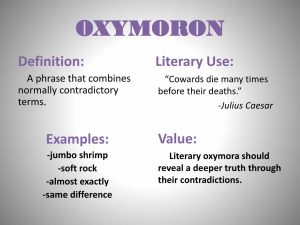In my ongoing posts about writing and the English language, here is another handout I shared with my students at the University of Illinois during my tenure there as a professor and dean. I hope you will find it useful.
An oxymoron is a figure of speech that combines two seemingly contradictory or opposite ideas to create a particular rhetorical or poetic effect and reveal a more profound truth. Generally, the ideas will come as two separate words placed side by side. The most common type of oxymoron is an adjective followed by a noun.
Oxymora (that’s the plural of oxymoron) are sometimes useful literary devices for writers. They are okay to use occasionally, but don’t overdo it! If you have read Shakespeare’s Romeo and Juliet you might recall this line which is a classic example of using an oxymoron in literature:
“Good night, good night! Parting is such sweet sorrow
That I shall say good night till it be morrow.”
Here is a list I used to give my journalism students at the University of Illinois. It is by no means exhaustive. This list is by no means comprehensive or complete. There are many more floating around out there. Enjoy!
- Orderly confusion
- Minor crisis
- Confirmed rumor
- Deafening silence
- Known secret
- Act naturally
- Found missing
- Resident alien
- Advanced BASIC
- Genuine imitation
- Airline Food
- Good grief
- Same difference
- Almost exactly
- Government organization
- Sanitary landfill
- Alone together
- Legally drunk
- Silent scream
- Living dead
- Small crowd
- Business ethics
- Soft rock
- Butt-Head
- Military Intelligence
- Software documentation
- New classic
- Sweet sorrow
- Childproof
- “Now, then …”
- Synthetic natural gas
- Passive aggression
- Taped live
- Clearly misunderstood
- Peace force
- Extinct Life
- Temporary tax increase
- Computer jock
- Plastic glasses
- Terribly pleased
- Computer security
- Political science
- Tight slacks
- Definite maybe
- Pretty ugly
- Twelve-ounce pound cake
- Diet ice cream
- Working vacation
- Exact estimate
- Microsoft Works



